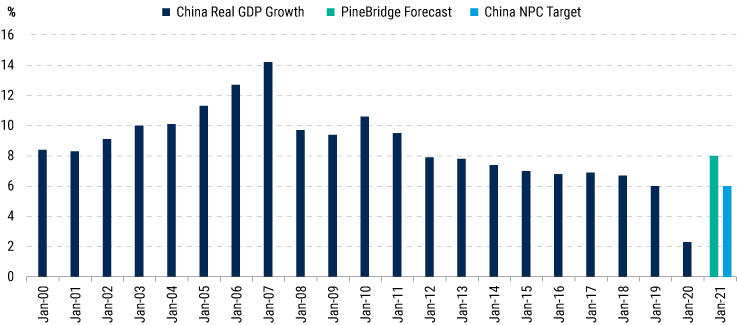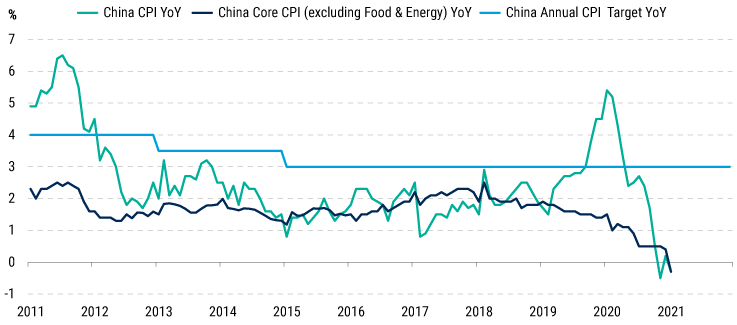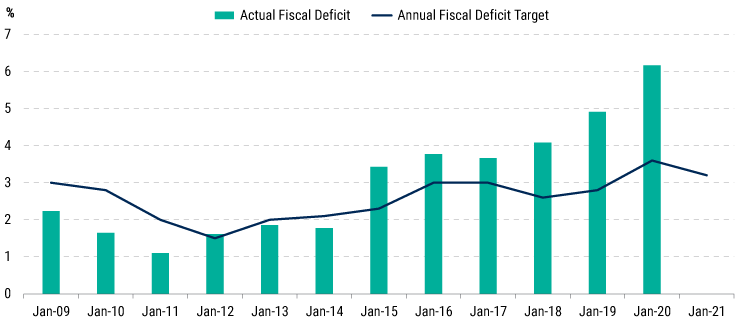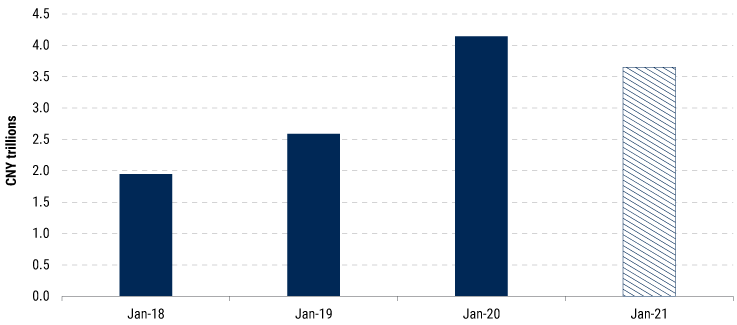At the recently concluded National People’s Congress (NPC), China’s top policymakers guided markets to expect less accommodation this year than in 2020 – and set the country up for success with a conservative growth target ahead of the high-stakes 20th Party Congress in 2022. The country’s five-year plan, however, reflects a post-Covid-19 economy with high ambitions, emphasizing Chinese innovation with scarce mention of the US.
A surprise growth target
China’s Economy Is Forecast to Grow Faster Than the Government’s Target

Core Inflation Has Fallen to Negative Levels

Downsizing the fiscal stimulus
Policymakers offered clearer direction on fiscal policy. China set a narrower fiscal deficit target this year of 3.2% of GDP, down from the record 3.6% set last year. According to our own calculations, the actual budget deficit last year rose to 6% of GDP. That said, China has missed its annual deficit targets since 2015. Nevertheless, the takeaway should be the direction and not the level. Unlike the US, which is set to pass another fiscal package in the trillions of dollars, the Chinese government has signaled that it is keen to take some pressure off the fiscal expenditure valve this year.
China Seeks to Scale Back Fiscal Spending
China fiscal deficit (% of GDP)

Reining in Local Government Bond Issuances

On the monetary side, policymakers kept the language from December 2020’s Central Economic Work Conference by promising that broad credit and money supply growth will be in line with nominal GDP growth and that monetary policy will be “flexible and … reasonable.” This is in line with our own forecasts. Total social financing growth, a broad measure of credit and liquidity, averaged approximately 12.5% in 2020, and we expect it to fall to 10% this year. M2 money growth averaged 10.3% last year, and we expect that rate to modestly slow to around 9% this year. Policymakers also promised to keep the yuan exchange rate “generally stable at an adaptive, balanced level.” That’s not too far off from our expectation of a slightly stronger yuan this year, with a year-end forecast of 6.35 to the US dollar.
Ambitious five-year targets
In addition to its 2021 targets, policymakers also released a list of 2021-2025 policy goals that put greater emphasis on technology and environmental conservation spending. Premier Li Keqiang called for research and development (R&D) spending to average 7% over the next five years and for it to take on a greater proportion of GDP as part of the “Sci-Tech Innovation 2030 Agenda.” Policymakers also plan to step up regulation on China’s fintech sector, “improving the mechanism for managing financial risks.” The abrupt cancellation of fintech giant Ant Group’s US$37 billion IPO last year just days before its dual listing in Shanghai and Hong Kong spooked markets after authorities said there were “issues” with the listing.
Additionally, China has emphasized greater expansion into nuclear energy in its five-year plan as the economy sets to expand non-fossil-fuel energy sources to 20% by 2025 and aim for net carbon neutrality by 2060.
With little mention of the US, Premier Li signaled China’s stepped-up engagement in global free trade agreements. He said China is actively considering joining the 11-nation Comprehensive and Progressive Agreement for Trans-Pacific Partnership (CPTPP), which evolved after the original TPP fell apart following US withdrawal in 2017. CPTPP already includes seven of the 15 member nations of the Regional Comprehensive Economic Partnership (RCEP), a free trade agreement anchored by China that accounts for approximately 30% of global GDP. The US is not a member of RCEP, and the Biden administration has yet to indicate whether it will participate in these trade agreements.
All told, while the NPC’s forward-looking goal setting guided markets to expect less accommodative policy this year and what looks to be an easily achievable growth target, plans for the next five years are loftier – envisioning a post-Covid-19 economy that prioritizes environmental protections and strengthens China’s position as a technological innovator.
For more of our views on forces driving China’s outlook, see “What’s Ahead for China’s Economy? Five Key Investor Questions Answered,“ published 16 February 2021.

